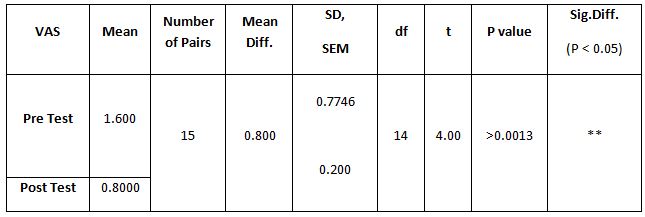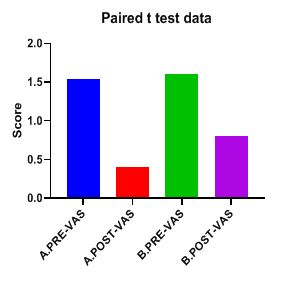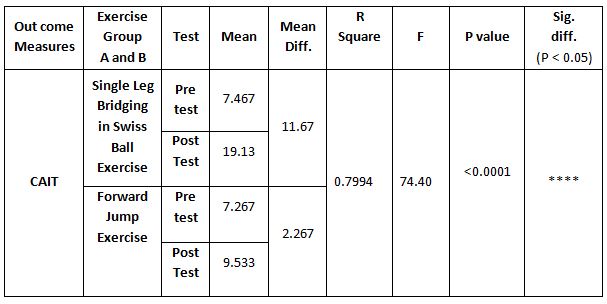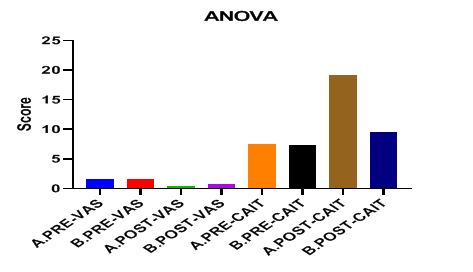| Jibi Paul1, Syeda Khanam P2, Kondaka Indira Pavani3, Jayalakshmi. N4 |
| Corresponding Author:1Professor, Faculty of Physiotherapy, A.C.S. Medical College and Hospital Campus, DR. MGR. Educational and Research Institute, Deemed to be University, Chennai, IndiaMail id: physiojibi@gmail.com |
Co-Author:
2Professor, East Point College of Physiotherapy, Bangalore, Karnataka, India
3Professor, Montessori College of Physiotherapy, Vijayawada, Andra Pradesh, India
4BPT Graduate, Faculty of Physiotherapy, A.C.S. Medical College and Hospital Campus, DR. MGR. Educational and Research Institute, Deemed to be University, Chennai, India
Abstract
Aim and objective of the study: The main objective of the study is to find the comparative effect of single leg bridging in Swiss ball over forward jump exercise on patients with functional ankle instability. Secondary objectives of the study are to find the individual effect of single leg bridging in Swiss ball and forward jump exercise on patients with functional ankle instability.
Methodology: This is a comparative pre and post type study. 30 subjects with age of 20-30 years of both male and female subjects were included in this study; they were divided in to 15 subjects in two groups. This study conducted at Department of Physiotherapy of ACS Medical college and Hospital, Chennai, for 3 session in a week for 4 weeks. Group A were given receive single leg bridging exercise in Swiss ball and Group B were given forward jump exercise. Both group trained for 10 repetitions of exercise in each session. Pain and functional disability was measured before and after the intervention session using the measurement tools VAS and CAIT. The special test done for confirming functional ankle instability by Talar Tilt Test.
Result: Comparative study between Group A and Group B showed significant difference in effectiveness of pain and improve Ankle instability with P value >0.0001, among patients with functional ankle instability.
Conclusion: This study is concluded that single leg bridging exercise found more effective on reduction of pain and improve ankle stability among patients with functional ankle instability.
| Keywords: Swiss ball, Single leg bridging, forward jump exercise; Ankle instability; Visual analog scale (VAS); Cumberland ankle Instability Tool (CAIT) |
Received on 28th October 2021, Revised on 25th November 2021, Accepted on 29th November 2021 DOI:10.36678/IJMAES.2021.V07I04.005
INTRODUCTION
Practical flimsiness of the lower leg joint has been characterized by Freeman as “a propensity for the foot to give way later a lower leg sprain.” Three variables thought to cause useful shakiness of the lower leg joint are anatomic or mechanical unsteadiness, muscle shortcoming, and deficiencies in joint proprioception. Cornwall showed that people with a background marked by reversal lower leg hyper-extends exhibit less dependability when playing out a solitary leg position than do no impaired subjects1-3.
Up to 70% of individuals have persevering manifestations of pain and precariousness later a straightforward lower leg sprain. Persistent lower leg precariousness, among the most well-known manifestations, is crippling and can prompt a wide range of disability. Chronic lower leg insecurity can incorporate repetitive injury, mechanical shakiness in which an essential mechanical restriction is lost, and utilitarian lower leg instability4-7.
As per this hypothesis, dynamic soundness of the lower leg joint relies upon the capacity of the evertors (Peronei) to respond rapidly to abrupt reversal annoyances, to develop sufficient pressure to forestall harmful scopes of lower leg movement, and accordingly to forestall injuries of the horizontal tendon complex of the lower leg. This hypothesis recommends that people with FI could have postponed and decreased reflex reactions in the evertor muscles of their impacted lower legs in response to an inversion stress in light of modified capsular and ligamentous afferent information8-10.
In any case, more current proof recommends that the dynamic control of lower leg dependability relies upon feed-forward engine control of the focal sensory system. It has been recommended that unseemly situating of the lower leg joint before ground contact during strolling may have significant ramifications for lower leg joint stability11-15.
METHODOLOGY
The study design is an experimental study. The study type is pre-post comparative study. Population: Only sports persons are included in the study. The study setting is conducted in Faculty of Physiotherapy, ACS Medical College campus, Velappanchavadi, Chennai. The sample size is 30 subjects. Study Sampling Method: Simple random sampling by lottery method used to divide the samples equally 15 subjects in each group. The study was conducted for duration of 4 weeks.
Selection Criteria
Inclusion Criteria: Age group 20-30 years, Both Male and Female subjects were included in this study.
Exclusion Criteria: Ankle pain above grade 2, Lower limb fracture, Dislocations of lower limbs, obese persons, cardiovascular patients
Measurement Tool of the study was Pain measured by VAS and Ankle instability by CAIT.
Procedure: This is a comparative study with pre and post intervention. 30 subjects with ankle instability are selected based on the inclusion criteria.
Group A (15 subjects) received single leg bridging in Swiss ball for period of 15 seconds holding of 3 repetitions and they were asked to do this for 4 weeks in alternative day.
Fig 1. Group A Single Leg Bridging Exercise In Swiss Ball
Group B (15 Subjects) received forward jump exercise for period 3 sets of 10 repetition for 4 weeks in alternative day. Pain and functional disability was assisted before and after the intervention session using the measurement tool. The special test done for confirming functional ankle instability was Talar Tilt Test. Pre and Post data was collected before and after the training program.
Fig 2 .Group B Forward Jump Exercise
Talar Tilt Test: The talar slant test or reversal move is performed with the patient prostrate or on their side, with foot loose. The gastrocnemius should likewise be loose by flexion of the knee. The bone is then shifted from one side to another into adduction and kidnapping. The discoveries ought to be contrasted and the contralateral side. Steal and rearrange the heel. On the off chance that a firm endpoint can’t be felt when contrasted and the contrary lower leg, suspect harm to the CFL. Note that the level of slant goes from o-23 degree. Much of the time, this test is troublesome, if certainly feasible, to perform auxiliary to patient torment and expanding.. This test is done to the subject for confirming functional ankle instability. The examination is demonstrated in the image below.
Fig 3. Talar Tilt Test
Data Analysis
Group A- Single Leg Bridging in Swiss Ball Exercise
The below table 1 shows significant difference in VASon patients with functional ankle instability with P value >0.0001

The above table 1 shows significant difference in VASon effectiveness of Single Leg Bridging in Swiss Ball Exercise among patients with functional ankle instability with P value >0.0001.

The above table 2 shows significant difference in VASon effectiveness of Single Leg Bridging in Swiss Ball Exercise among patients with functional ankle instability with P value >0.0013.
Group B -Forward Jump Exercise

The above table 3 shows significant difference in CAIT within the Group B on the effectiveness of Forward Jump Exercise among patients with functional ankle instability with P value >0.0001.

The above table 4 shows significant difference in CAIT within the Group B on effectiveness of Forward Jump Exercise among patients with functional ankle instability with P value >0.0001.


The below table 5 shows significant difference on VAS between Group A and B among patients with functional ankle instability with P value <0.0001.

The above table 5 shows significant difference on VAS between Group A and B among patients with functional ankle instability with P value <0.0001.

The above table 6 shows significant difference on CAIT between Group A and B among patients with functional ankle instability with P value <0.0001.

RESULT
Total 15 participants of patients with functional ankle instability were included in the study base on specific selection criteria.
In study pain has reduced with mean difference of 1.133, by Single Leg Bridging in Swiss Ball Exercise with P value >0.0001, among patients with functional ankle instability.
In study pain has reduced with mean difference of 0.80, by Single Leg Bridging Exercise with P value >0.0001, among patients with functional ankle instability.
Shoulder function has improved with mean difference of 11.67, by Forward Jump Exercise with P value >0.0001, among patients with functional ankle instability.
Shoulder function has improved with mean difference of, by 2.267, Forward Jump Exercise with P value >0.0001, among patients with functional ankle instability.
Comparative study between Group A and Group B showed significant difference in effectiveness of pain and improve Ankle instability with P value >0.0001 respectively among patients with functional ankle instability.
Single Leg Bridging Exercise found more effective on reduction of pain and improve Ankle instability among patients with functional ankle instability with mean difference of 1.133 and 11.67 respectively, while compare the mean difference on effect of Forward Jump Exercise with 0.80 and 2.267 respectively.
DISCUSSION
The capacity to recognize movement in the foot and make postural changes because of the identified movements is significant in the anticipation of lower leg injury. Essentially, the capacity of a person to detect the place of the foot preceding impact point strike is absolutely critical. Studies have shown that useful lower leg precariousness brings about a diminished capacity to keep up with balance and abatement in joint position sense. Constant lower leg shakiness is a typical issue in sports and among dynamic individual16, 17.
The present study investigated that to compare the effect of single leg bridging in Swiss ball over forward jump exercise on patients with functional ankle instability. After the rehabilitation the ankle instability is measured by using CAIT (Cumberland Ankle Instability Tool)18.
This review has recommended that lower leg injury might cause interruption of joint afferents situated in the supporting tendons and case, prompting an impedance of the postural control framework. Utilizing an altered Rom-berg’s test, they tracked down a reduction in the capacity to keep up with static equilibrium on the harmed appendage when contrasted with the unharmed appendage of patients with one-sided lower leg injury. From their finding of diminished postural control, they proposed a halfway separation of joint mechano-receptors in the practically unsound lower leg, which added to indications of useful unsteadiness. Various mechanoreceptors are available in joint container, tendon, muscle, and skin. Mechanoreceptors are delicate to joint strain and pressure brought about by both powerful development and static position19.
This review has detailed a diminishing in manifestations of practical flimsiness and rehashed scene of injury following a preparation routine of equilibrium type works out. Peters et al, detailed after a parallel lower leg sprain, 10% to 30% of people report tenacious indications or reinjury20.
This study has suggested that the postural control and functional limitations exist in individuals with CAI. In addition, rehabilitation appears to improve these functional limitations. The result of the present study reported that the single leg bridging exercise shows significant improvement in patient with ankle instability 21.
Ethical clearance: There was no risk of conducting this study.Ethical clearance was obtained from the ethical Institutional Review Board of Faculty of Physiotherapy, Dr. MGR. Educational and Research Institute, Chennai with reference No. E17/PHYSIO/IRB/2019-2020 approval letter dated 07/01/2020.
Conflicts of Interest: There is no conflict of interest to conduct this study.
Fund for the study: This is self-funded study.
CONCLUSION
This study is concluded that the single leg bridging exercise found more effective on reduction of pain and improve ankle stability among patients with functional ankle instability.
There was a significant reduction of pain and improvement of functional ankle instability in both groups. Comparatively there was more reduction of pain and improvement of functional ankle instability in subjects who received single leg bridging exercise in Swiss ball.
REFERENCES
1. Susan. L Rozzi,Scott M. lephart, Rob Sterner, Lori Kuligowski, Balance training on persons with functionally unstable ankles, J Ortho sports Phys Ther, August 1999; 29(8): 478-486.
2. Claire E. Hiller, Kathryn M. Refshauge, Anita C. Bundy, Rob D. Herbert, Sharon L. Kilbreath, The Cumberland Ankle Instability Tool: A Report of Validity and Reliability Test, Arch Phys Med Rehabl, 2006; 87:1235-1241.
3. Eamonn Delahunt, Kenneth Monaghan, and Brian Caulfield, Altered Neuromuscular Control and Ankle Joint Kinematics During Walking in Subjects With Functional Instability of the Ankle Joint,The American journal of sports medicine, 2006; 34(12): 1970-1976.
4. Jay Hertel, Functional Anatomy, Patho-mechanics, and Pathophysiology of Lateral Ankle Instability, Journal of Athletic Training, December 2002; 37(4):364-375.
5. Julie N. Bernier, David H. Perrin, Effects of coordination training on proprioception of the functionally unstable ankles, Research study, April 1998; 27: 264-275.
6. Carrie L. Docherty, Josef H. Moore, Brent L. Arnold, Effects of Strength Training on Strength Development and Joint Position Sense in Functionally Unstable Ankles, Jour of athletic training, Decemeber 1998; 33(4) : 310-314.
7. Tamerah N. Hunt, Michael S. Ferrara. The Reliability of the Modified Balance Error Scoring System, Clin J Sport Med, November 2009; 19(6):471- 474.
8. Salim Vahedi Namin, Amir Letafatkar, Vida Farhan, Effects of balance training on movement control, balance and performance in females with chronic ankle instability, Hormozgan Medical Journal, September 2017; 21(3):188-199.
9. Mutlu Cug, Effects of Swiss Ball Training on Knee Joint Reposition Sense, Core Strength and Dynamic Balance In Sedentary Collegiate Students, February 2012; 33(6): 24-78.
10. Sheri A. Hale SA, Hertel J, Olmsted-Kramer LC. The effect of a 4-week comprehensive rehabilitation program on postural control and lower extremity function in individuals with chronic ankle instability. J Orthop Sports Phys Ther.2007; 37:303–311.
11. Delahunt E, Monaghan K, Caulfield B. Altered neuromuscular control and ankle joint kinematics during walking in subjects with functional instability of the ankle joint. Am J Sports Med. Dec 2006; 34(12):1970-1976.
12. Marcos De Noronha M, Refshauge KM, Kilbreath SL, Figueiredo VG. Cross-cultural adaptation of the Brazilian-Portuguese version of the Cumberland Ankle Instability Tool (CAIT) Disabil Rehabil. 2008; 30(26):1959–1965.
13. Hiller CE, Refshauge KM, Bundy AC, Herbert RD, Kilbreath SL. The Cumberland Ankle Instability Tool: a report of validity and reliability testing. Arch Phys Med Rehabil. 2006; 87(9):1235–1241.
14. Ross SE, Guskiewicz KM, Gross MT, Yu B. Assessment tools for identifying functional limitations associated with functional ankle instability. J Athl Train. 2008; 43(1):44–50.
15. Rozzi, S. L, S. M. Lephart, R. Sterner, and L. Kuligowski. Balance training for persons with functionally unstable ankles. J Orthop Sports Phys Ther 1999. 29 (8):478–486.
16. Alex J Nelson, Christy L Collins, Ellen E Yard, Ankle injuries among united states high school sports athletes, 2005-2006 42 (3), 381, 2007.
17. Ali MD Nadzalan, Nur Iklwan Mohammed, Jeffrey low fookLee, ChamnanChinnasee, The effects of step verus jump forward jump exercise training on muscle architecture among recreational badminton players, Journal 2017; .35 (8), 1581-1587.
18. Gregory D Myer, Kelvin R Ford, Jensen L bBrent, Timothy E Hewett, The effects of plyometric vs. dynamic stabilization and balance training on power, balance, and landing in female atheletes, 2006; 20(2), 345.
19.Narges Pirmohammadi, Elham Shirzad, Effects of a Four-week core stability training program on the kinetic parameters in atheletes with Functional ankle instability, 2019; 11(1), 33-42.
20. Marcos DE Noronha, Kathryn M Refshauge, Sharon L Kilbreath, viltor G Figueiredo, Cross-cultural adaptation of the Brazilian-Portuguese version of the Cumberland Ankle Instability Tool, 2008; 30(26), 1959-1965.
21. Gwendolyn Vuurberg, Lana kluit, C Niek van Dijk, The Cumberland Ankle Instability Tool (CAIT) in the Dutch population with and without complaints of ankle instability, 2018; 26(3), 882-891.
Citation:
Jibi Paul, Syeda Khanam P, Kondaka Indira Pavani, Jayalakshmi. N (2021). Comparative effect of single leg bridging exercise in swiss ball over forward jump exercise on patient with functional ankle instability, ijmaes; 7(4); 1155-1164.


Leave a Reply